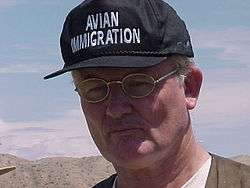Peter Pritchard
| Dr. Peter Pritchard | |
|---|---|
 | |
| Born |
June 26, 1943 England |
| Fields | Zoology |
| Institutions | Chelonian Research Institute |
| Alma mater |
University of Florida Oxford University |
| Known for | Work for the Conservation of turtles |
Peter Pritchard (born 1943) is a leading turtle zoologist. Educated at Oxford University and the University of Florida, where he earned his Ph.D. in Zoology, he is most commonly known for his campaign of almost 40 years for the conservation of turtles. Appropriately, his privately funded Chelonian Research Institute, for the study and preservation of turtles, is located in Oviedo, Florida, United States, just a half hour's drive from Disney World. Frank Sulloway had noted that Pritchard 'has amassed nearly 12,000 tortoise and turtle skeletons - the third largest collections in the world.'
Arguably, Pritchard's most important and innovative work has been along the Atlantic coast of Guyana, the South American country that is home to four of the world's seven known sea turtle species: the leatherback, green, hawksbill and the olive ridley. By the 1960s, overhunting by local Arawak Indians — themselves an endangered group — had ravaged the turtle population.
Pritchard tried to save both the turtles and the tribe. He lobbied Guyana and private sources for grants that lowered the Arawak consumption of turtle meat and he helped them to farm chickens. He hired Arawaks at his study camp to tag turtles for research and to police nesting grounds to prevent attacks from poachers. The turtle population has increased, he says, because turtle protection is now "a family discipline thing" among Arawaks "rather than an outsider laying down the law." Along the way, Pritchard's own scholarship has benefited from centuries' worth of tribal turtle knowledge. He has also done extensive study and written books about alligator snapping turtles and Galapagos tortoises.
Eponyms
Pritchard is honored in the scientific names of two turtles, Chelodina pritchardi and Mauremys pritchardi.[1]
References
- ↑ Beolens, Bo; Watkins, Michael; Grayson, Michael (2011). The Eponym Dictionary of Reptiles. Baltimore: Johns Hopkins University Press. xiii + 296 pp. ISBN 978-1-4214-0135-5. ("Pritchard", pp. 211-212).
Further reading
- Sulloway, F.J. (2006). "Is lonesome George really lonesome?" Skeptic 12 (4): 58-70.
External links
- Environmental Science Program .
- Chelonian Research Institute official website of the Chelonian Research Institute in Oviedo, FL.
- TIME.com: Heroes of the Planet .
- Interview .